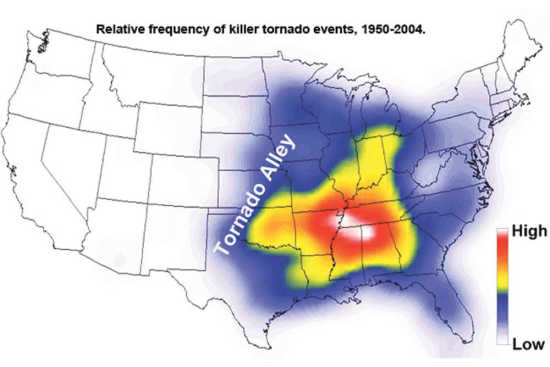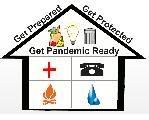# 2897
While this blog's primary focus may appear to on emerging infectious diseases and pandemic influenza, at the heart of the conversation is really the need for everyone to become more prepared to deal with disasters.
With that in mind, from time to time I discuss other threats, such as earthquakes, hurricanes . . . and today, tornadoes.

For much of the United States, Spring is tornado season.
March, April, and May generally see the strongest, and most frequent tornadoes, but in truth - these violent windstorms can occur any time of the year - particularly in the south.
In an average year, more than 1,000 tornadoes are reported in the United States. It is likely that the actual number is considerably higher, as not all tornadoes occur in areas where they can be seen or confirmed.
Many people believe that tornadoes are just an American problem, but as you can see by the map below, many parts of the world can see these types of damaging storms.
All but a small part of the United States is vulnerable to these storms, but the stongest of these storms generally occur in an area we call Tornado Alley, which runs from middle Texas north though Oklahoma, Kansas, Nebraska and South Dakota.
This is the area where you will generally find the largest and most powerful tornadoes; the F5 wedge type.
Fortunately, much of the mid-west is sparsely populated, and so the number of tornado deaths that occur here are actually less than in other areas of the country.
While Florida sees a high number of tornadoes each year, they are generally the smaller F1 or F2 tornadoes. Destructive, yes. And certainly capable of causing fatalities. But not in the same league as the tornadoes of the mid-west.
Surprisingly, new research has show that residents of Tennessee are at the greatest risk of death from tornadoes, at least according to Walker Ashley, a Northern Illinois University meteorologist.
This bit of fascinating reporting comes from the Dyersburg State Gazette.
Researchers: Tenn. at greatest risk of tornado deaths
Thursday, March 5, 2009

The epicenter of tornado deaths from 1950 to 2004 stretches across the Mid-South, from the Missouri bootheel to northwestern Alabama. Dyersburg sits on the boundary line, according to a map drawn by Northern Illinois University researchers.
Tennessee may not be part of the traditional Tornado Alley, but recent research show tornadoes here have the most potential for deadly damage.
Tornado Alley is traditionally thought to include parts of Texas, Oklahoma, Kansas and Nebraska. More tornadoes are documented in this geographic region than in any other spot on Earth.
But meteorologists and researchers question whether the Great Plains' version of Tornado Alley actually poses the greatest threat.
"Dixie Alley," a lesser-known version of Tornado Alley, has about the same number of strong and violent tornadoes but more killer tornadoes.
Dixie Alley is defined as an area stretching from Arkansas and Louisiana to Middle Tennessee and Georgia, from Tennessee's northern boundary to the Gulf Coast. Alan Gerard and John Gagan of the National Weather Service office in Jackson, Miss., and John Gordon of the NWS office in Louisville Ky., considered the differences in "A Comparison of Tornado Statistics from Tornado Alley and Dixie Alley." A slide presentation of their findings is available online at: www.srh.noaa.gov/jan/dixieAlley/.
Dixie Alley, they reported, experiences tornado threats most of the year while the threat in the Great Plains Tornado Alley occurs mainly April through June.

At 45.8 percent, Tennessee has a higher percentage of nocturnal tornadoes than any other state in the nation. Joining Tennessee at the top of the list are: Arkansas, 42.5; Kentucky, 41.5; Mississippi, 39.6; Oklahoma, 36.7; Missouri, 36.3; Alabama, 36.1; Louisiana, 35.3; West Virginia, 35.2; Georgia, 33.3; and Indiana, 32.6. Green states range from 24.0 to 31.9 percent; mustard states, 16.0 to 23.9; orange states, 8.0 to 15.9; and red states, 0.1 to 7.9. Twisters that occur between midnight and dawn are 2.5 times more likely to be killer tornadoes.
By all means, read the entire article.
NOAA WEATHER RADIO, once thought of as mainly a source of local weather information, has now become an `All-Hazards' alert system as well.
This from the NOAA Weather Radio Page.
Working with the Federal Communication Commission's (FCC) Emergency Alert System , NWR is an "All Hazards" radio network, making it your single source for comprehensive weather and emergency information. In conjunction with Federal, State, and Local Emergency Managers and other public officials, NWR also broadcasts warning and post-event information for all types of hazards – including natural (such as earthquakes or avalanches), environmental (such as chemical releases or oil spills), and public safety (such as AMBER alerts or 911 Telephone outages).
In order to receive these broadcasts, you need a special receiver. Many of these radios have a special `Tone Alert', and will begin playing once they receive a special alert signal from the broadcaster.
Like having an emergency kit, a first aid kit, and a portable AM/FM radio - having a weather radio is an important part of being prepared.
From READY.GOV we get the following advice to prepare for dealing with a tornadoes. They, like many other governmental agencies, wants Americans to be better prepared to deal with emergencies.
Tornadoes
Tornadoes are nature's most violent storms. They can appear suddenly without warning and can be invisible until dust and debris are picked up or a funnel cloud appears. Planning and practicing specifically how and where you take shelter is a matter of survival. Be prepared to act quickly. Keep in mind that while tornadoes are more common in the Midwest, Southeast and Southwest, they can occur in any state and at any time of the year, making advance preparation vitally important.
Step 1: Get a Kit
- Get an Emergency Supply Kit, which includes items like non-perishable food, water, a battery-powered or hand-crank radio, extra flashlights and batteries.
- Store it in your shelter location
Step 2: Make a Plan
Prepare Your Family
- Make a Family Emergency Plan. Your family may not be together when disaster strikes, so it is important to know how you will contact one another, how you will get back together and what you will do in case of an emergency.
- Plan places where your family will meet, both within and outside of your immediate neighborhood.
- It may be easier to make a long-distance phone call than to call across town, so an out-of-town contact may be in a better position to communicate among separated family members.
- You may also want to inquire about emergency plans at places where your family spends time: work, daycare and school. If no plans exist, consider volunteering to help create one.
- Determine in advance where you will take shelter in case of a tornado warning:
- Storm cellars or basements provide the best protection.
- If underground shelter is not available, go into an interior room or hallway on the lowest floor possible.
- In a high-rise building, go to a small interior room or hallway on the lowest floor possible.
- Stay away from windows, doors and outside walls. Go to the center of the room. Stay away from corners because they attract debris.
- A vehicle, trailer or mobile home does not provide good protection. Plan to go quickly to a building with a strong foundation, if possible.
- If shelter is not available, lie flat in a ditch or other low-lying area. Do not get under an overpass or bridge. You are safer in a low, flat location.
- Plan to stay in the shelter location until the danger has passed.
- Take a Community Emergency Response Team (CERT) class from your local Citizen Corps chapter. Keep your training current.
Step 3: Be Informed
Familiarize yourself with the terms that are used to identify a tornado hazard.
- A tornado watch means a tornado is possible in your area.
- A tornado warning is when a tornado is actually occurring, take shelter immediately.
Listen to Local Officials
Learn about the emergency plans that have been established in your area by your state and local government. In any emergency, always listen to the instructions given by local emergency management officials.
For further information on how to plan and prepare for tornadoes as well as what to do during and after a tornado, visit: Federal Emergency Management Agency, NOAA Watch or American Red Cross.
Most Americans are woefully unprepared to deal with emergencies. This despite dozens of major disasters (often weather related) that occur every year in this country.
Agencies like FEMA, READY.GOV and the HHS are constantly trying to get the preparedness message out, so that when (not `if') a disaster does occur, human losses can be minimized.
For more information on how to prepare for emergencies, up to and including a pandemic, the following sites should be of assistance.
FEMA http://www.fema.gov/index.shtm
READY.GOV http://www.ready.gov/
AMERICAN RED CROSS http://www.redcross.org/
For Pandemic Preparedness Information: HHS Individual Planning Page
For more in-depth emergency preparedness information I can think of no better resource than GetPandemicReady.Org.
Related Post:
Widget by [ Iptek-4u ]





